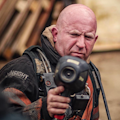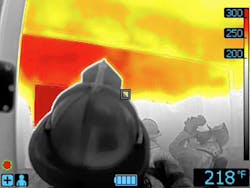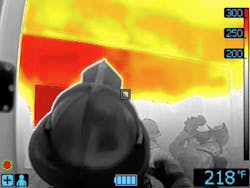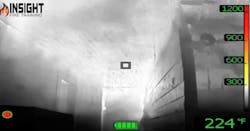Detecting Thermal Rebound in a Structure Fire with Thermal Imaging Cameras
What is thermal rebound? The thermal rebound of a fire is a technical way of saying that heat comes back. Firefighters can encounter this when the hoseline is shut down as they begin an advance. In other words, what was stopped a moment ago comes back quickly—and in many cases with a vengeance.
Why do firefighters not recognize this phenomenon? Far too often, firefighters fail to utilize the thermal imaging camera (TIC) to their advantage during a fire attack; therefore, they have lost sight (pun intended) of what’s occurring around them. However, by utilizing the TIC in live fire training, firefighters can visualize and understand conditions as they make their push into an actual structure fire. This builds an additional skill for firefighters to use to their advantage at their next fire.
Why should we respect the rebound? The first reason is because of the power of the thermal energy. If firefighters are unable to reach the seat of the fire from where they are, the fire will continue to grow. Some might consider this an oversimplification of the basics, but this concept is far too important to neglect.
Rebound on the TIC display
The growth of a fire expresses itself in terms of pressure buildup. Nature hates an imbalance, so the high pressure that’s created in a fire compartment always seeks a release point; thus, high pressure always spreads to lower-pressure areas. The more pressure that’s built, the faster the pressure will try to relieve itself. This circumstance can be seen in the thermal rebound.
Thermal rebound’s path
Another reason why it’s important for members who are on the fireground to be mindful of the power of the thermal rebound is because you often are in the only exhaust path. If the lower-pressure zone that the high pressure wants to reach is behind you (the entry point), that puts you in the path of the rebound. You still will see thermal rebound if there is another ventilation point present, but it might not be as powerful as it would be if there only is one exit behind you.
Thermal rebound’s speed
Why else should firefighters respect the rebound? The rebound demands respect through the speed by which it occurs. When you don’t see thermal rebound occurring with your naked eyes through the dark environment that surrounds you, there’s no way to appreciate its speed. When viewed on the display of the TIC, the speed of the rebound catches many off guard.
Preheated surfaces
As firefighters, you’re aware that fire extends its boundaries by heating up surfaces, which begin to break down and off-gas flammable vapors. This is the process of pyrolysis, or the decomposition of a substance through the action of heat. As flammable vapors ignite, they preheat the surfaces that are around them, and the cycle repeats itself. Therefore, a preheated surface reaches ignition faster.
In “Attacking and Extinguishing Interior Fires,” Lloyd Layman wrote, “Fire extends its boundaries by transmitting heat to exposed combustibles, and it is of utmost importance that those engaged in firefighting activities have a thorough understanding of the fundamentals that govern the transfer of heat.”If you cool a surface sufficiently with a hose stream, you interrupt the ignition process and cause a momentary stall in the progression of the fire. However, keep in mind that when you remove the cooling to make an advance, the process doesn’t restart at square one (whatever normal ambient temperature the surface is). The surface already is preheated, and the rebound is faster. It might take only seconds for the fire to spread right back to where it was when you first opened the line. In other words, if you choose to use a “hit and move” fire attack strategy, be sure that the heat isn’t out moving you.
Thermal rebound’s spread
A final reason to respect the rebound is that of spread. Depending on building layout and ventilation openings, it’s possible to have fire move in different directions. If you don’t utilize or interpret TICs properly, you will be blind to this potentially grave situation. A firefighter might cool an area only to have the heat rebound from a different direction that was uncooled. A comparison might be a basketball player who gets good box-out position at the rim and is ready to rebound the ball to the right only to have the ball clang off of the rim to the left. The player did his/her job, but the result still was loss of ball control.
Many firefighters are taught in burn facilities that they only have one path to the fire room. By moving from point A to point B, the situation is contained to what is occurring in front of the hose team. However, a fire in a structure that has multiple rooms is a different situation. A fire that comes out of a room into a hallway might be cooled from one side by the hose team. As the team shuts down to move closer, the fire will rebound toward the team, but the fire also will travel down the hallway in the other direction. The rebound is split, based on the temperature and pressure differences that are within the respective layout of the structure between the fire and the nozzle. Remember, the surfaces that are closest to the crews were cooled slightly, so the rebound must reheat them. However, if the surfaces that are on the other side never were cooled, the rebound will be faster in that direction, because it has hotter temperatures to work with.
TIC-directed attack
In a recent training that was conducted in a facility that had multiple rooms and configurations, the crew made a TIC-directed attack at a 90-degree angle to the fire room. When the line was shut down to advance, the rebound came toward the crew by reheating the surfaces that were cooled momentarily. This isn’t surprising, but it can be if a firefighter hasn’t witnessed the rebound through the eyes of a TIC.
As the rebound hit the cooler surfaces and began to build directly in front of the hose team, a good amount of the rebound came out of the fire room and turned down the hall toward the crew’s left. It followed the high-pressure track and crossed hotter surfaces than what was right in front of the crew. The process was repeated as the crew shut down its line periodically to advance toward the fire room door.
Dealing with thermal rebound
Be aware of it. Firefighters can’t appreciate the power, speed and spread of the rebound if they never trained in live fire conditions. Theatrical smoke is a great tool for many types of training, but TIC training isn’t one of those.
The TIC recognizes heat signatures and gives the operator information about the surrounding conditions. Heat signatures are lacking in theatrical smoke. You only can learn to respect thermal rebound if you see thermal rebound (hot convection currents) during training.
Learn to flow and go. Determined and seasoned fire crews know how to properly flow water as they make a push. It isn’t always easy to do, but it’s the best way to keep surfaces cooled and to reduce the effects of the thermal rebound. The amount of flowing water should be sufficient to knock back the heat to make the advance.
Make fast pit stops. There will be times when you can’t flow and go very effectively. It might be because of obstacles, building layout, low staffing and/or other challenges. However, you can improve your chances of success by keeping your stops (nozzle closures) to a minimum. The longer that the line doesn’t flow water, the more progressed the thermal rebound is.
Cool surfaces. Your efforts should make the rebound work harder to reheat the area above and around you. We advocate that firefighters “erase the heat” as they go. We understand that the heat isn’t completely erased, but the efforts of surface cooling are confirmed as they proceed toward the seat of the fire. The results of several studies show that penciling isn’t sufficient to provide the adequate cooling that’s needed.
Control ventilation points. Don’t allow yourself to get caught in the exhaust path that the thermal rebound is trying to take. Firefighters should be aware and on the lookout for the convection currents that try to make their way around you. You must deal with the situation by the proper opening or closing of doors and windows or by properly executing vertical ventilation with well-coordinated suppression efforts.
Use a TIC. Firefighters must learn what model of TIC that their department has and how it functions. This includes learning the capabilities as well as the limitations.
You should know what rebound looks like through the eyes of their TIC and how rebound affects surfaces above and around them and observe the cooling properties of the hose stream through the lens of the TIC.
Where you’re going
The thermal rebound can have significant consequences for hose teams and potential victims if firefighters don’t deal with it properly. By being aware of its speed, power and spread, firefighters can put themselves in the best possible tactical position to deal with it. Firefighters should use the TIC to determine conditions, stream placement and efficiency. This will reinforce the mindset to use the hose stream to cool where you are as well as where you are going. Most importantly, firefighters should use their greatest resource, their mind, and they should tap that resource so as to make informed decisions. Respect the rebound.
About the Author

Andrew Starnes
Andrew Starnes has been involved with the fire service as a volunteer since 1992 and as a career firefighter since 1998. He retired as a battalion chief and 25-year career with a large career department in North Carolina. Starnes is Level II Thermography Certified and is the founder of Insight Training LLC, which developed the first thermography-based firefighter certification that's credentialed through Infrared Training Center. He is a fire service website contributor on the topics of thermal imaging, fire behavior, leadership, behavioral health and faith-based devotions. Starnes has trained and/or assisted departments with thermal imaging training in all 50 states and in numerous other countries.
John Lightly
John Lightly is a battalion chief for a career urban fire department in northeastern Ohio. He has been a member of the fire service for 27 years, getting his start as a volunteer in a small rural department. Lightly is a state of Ohio Paramedic, Fire Instructor, Live Fire Instructor, Incident Safety Officer, Fire Officer 1 and Fire Officer 2. He is part of the instructor cadre for Insight Training LLC and is certified as a Level 1 Thermographer.






